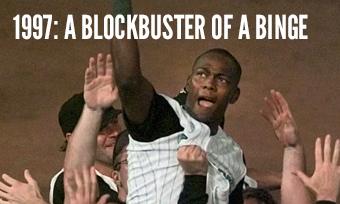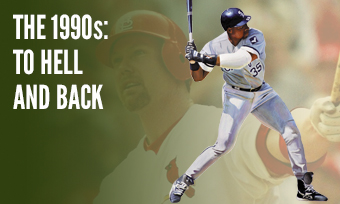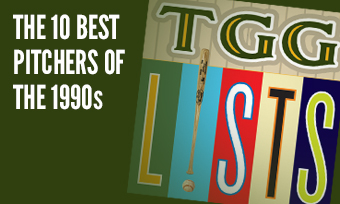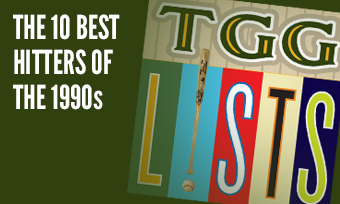The Yearly Reader
Leaders and Honors, 1997
Our list of baseball’s top 10 hitters and pitchers in both the American League and National League for the 1997 baseball season, as well as the awards and honors given to the game’s top achievers of the year.
The National League’s Top 10 Hitters, 1997
Bold type in brick red indicates league leader.
1. Larry Walker, Colorado
Key Numbers: .366 average, 143 runs, 208 hits, 46 doubles, 49 home runs, 130 RBIs, 14 hit-by-pitches, 23 stolen bases, .452 on-base percentage, .720 slugging percentage.
Before you think that Walker’s eye-popping figures were Coors Field-enhanced, it should be noted that he hit .346 with 29 homers on the road.
2. Jeff Bagwell, Houston
Key Numbers: 162 games, .286 average, 109 runs, 40 doubles, 43 home runs, 135 RBIs, 127 walks, 27 intentional walks, 16 hit-by-pitches, 31 stolen bases.
Along with inseparable “Killer B” teammate Craig Biggio, Bagwell played every game and continued to inflict a killer sting upon opponents.
3. Barry Bonds, San Francisco
Key Numbers: .291 average, 123 runs, 26 doubles, 5 triples, 40 home runs, 101 RBIs, 145 walks, 34 intentional walks, 37 stolen bases.
Bonds knocked in a NL-record 32 runs in April, before matching his father (Bobby Bonds) for the most 30-30 seasons in a career with five.
4. Mike Piazza, Los Angeles
Key Numbers: .362 average, 104 runs, 201 hits, 32 doubles, 40 home runs, 124 RBIs.
Piazza became the third catcher to club 40 homers, the first full-time catcher to hit above .360, and the second player of any kind to blast a baseball out of Dodger Stadium.
5. Craig Biggio, Houston
Key Numbers: 162 games, .309 average, 146 runs, 191 hits, 37 doubles, 8 triples, 22 home runs, 81 RBIs, 84 walks, 34 hit-by-pitches, 47 stolen bases, 0 grounded into double plays.
Showing little fear at the plate—it was little issue with an industrial-strength elbow pad that got him plunked a career-high 34 times—the consistent Biggio was one of the few (if perhaps only) players to score 20 runs in each month of the season.
6. Andres Galarraga, Colorado
Key Numbers: .326 average, 109 runs, 178 hits, 37 doubles, 40 home runs, 130 RBIs, 11 stolen bases, 10 sacrifice flies.
They were wearing out the tape measuring equipment on Galarraga’s massive home runs; one at Miami was tagged at 529 feet, while two others neared 500.
7. Tony Gwynn, San Diego
Key Numbers: .372 average, 97 runs, 220 hits, 49 doubles, 17 home runs, 119 RBIs, 12 stolen bases, 12 sacrifice flies.
Evoking Ted Williams as never before, Gwynn was hitting over .400 and on pace for 25 homers on July 14 before “cooling” off. He was always hot with runners in scoring position—batting a whopping .459 over 146 at-bats in said situations.
8. Ray Lankford, St. Louis
Key Numbers: 133 games, .295 average, 94 runs, 36 doubles, 31 home runs, 98 RBIs, 95 walks, 21 stolen bases.
A year after hitting none of his 21 home runs against southpaws, the left-handed-hitting Lankford conked out 12 of his 31 against them—with a better average (.301) than against righties (.292).
9. Raul Mondesi, Los Angeles
Key Numbers: .310 average, 95 runs, 191 hits, 42 doubles, 5 triples, 30 home runs, 87 RBIs, 32 stolen bases.
With a pair of round-trippers in his penultimate game of the year, Mondesi ensured the Dodgers’ second ever season (after 1977) with four team members hitting at least 30. For the 26-year-old Dominican, it would be the first of three straight years at 30 or more.
10. Chipper Jones, Atlanta
Key Numbers: .295 average, 100 runs, 176 hits, 41 doubles, 21 home runs, 111 RBIs, 20 stolen bases.
Most major leaguers were starting to dislike the 25-year-old Jones for his public arrogance. Opposing pitchers continued to dislike him for making them look bad.
The American League’s Top 10 Hitters, 1997
1. Ken Griffey Jr., Seattle
Key Numbers: .304 average, 125 runs, 185 hits, 34 doubles, 56 home runs, 147 RBIs, 23 intentional walks, 15 stolen bases, .646 slugging percentage.
Junior complained that Mariners fans weren’t respecting him, but perhaps they were too busy trying to absorb his incredible numbers that earned him unanimous MVP honors.
2. Frank Thomas, Chicago
Key Numbers: .347 average, 110 runs, 184 hits, 35 doubles, 35 home runs, 125 RBIs, 109 walks, .456 on-base percentage.
Before sliding into a two-year slump, the Big Hurt took home his lone batting crown while pacing the AL for the fifth (and final) time in on-base percentage.
3. Edgar Martinez, Seattle
Key Numbers: .330 average, 104 runs, 179 hits, 35 doubles, 28 home runs, 108 RBIs, 119 walks, 11 hit-by-pitches, 21 grounded into double plays.
At the height of his Hall-of-Fame powers, the full-time DH proved that having to take the field in National League parks as interleague play commenced didn’t distract his batting; he was 6-for-14 with five home runs.
4. Tino Martinez, New York
Key Numbers: .296 average, 96 runs, 176 hits, 31 doubles, 44 home runs, 141 RBIs, 13 sacrifice flies.
Perhaps because Seattle was too small a town for two Martinez’s, Tino parted from Edgar and, in his second season at the Big Apple, was so good that he temporarily made Yankee fans forget about his popular predecessor at first base, Don Mattingly.
5. Bernie Williams, New York
Key Numbers: 129 games, .328 average, 107 runs, 167 hits, 35 doubles, 6 triples, 21 home runs, 100 RBIs, 15 stolen bases.
The seventh-year Yankee completed his education from common player to popular All-Star, making his first of five straight Midsummer Classics.
6. Jim Thome, Cleveland
Key Numbers: .286 average, 104 runs, 25 doubles, 40 home runs, 102 RBIs, 120 walks.
The prime-time slugger made sure that no one in the AL Central would catch Cleveland in the standings; he hit .335 with 17 of his 40 homers in 45 games against the Indians’ four divisional opponents.
7. Nomar Garciaparra, Boston
Key Numbers: .306 average, 684 at-bats, 122 runs, 209 hits, 44 doubles, 11 triples, 30 home runs, 98 RBIs, 22 stolen bases.
Garciaparra made the most of his astonishing Rookie-of-the-Year campaign, setting a Boston record for at-bats and compiling a career-high 209 hits. (He would fall short of 200 going forward, making the 190s five times.)
8. Juan Gonzalez, Texas
Key Numbers: 133 games, .296 average, 87 runs, 42 home runs, 131 RBIs.
Despite missing the entire month of April, Gonzalez still eventually ended up placing third in the AL RBI race; he knocked in at least five in six different games.
9. Rusty Greer, Texas
Key Numbers: .321 average, 112 runs, 193 hits, 42 doubles, 26 home runs, 87 RBIs, 83 walks.
Not to be outdone by Gonzalez, Greer—easily the Rangers’ most underrated hitter—drove in a career-high six runs on August 22 against the White Sox—then did it again the very next day against the same team.
10. Dave Justice, Cleveland
Key Numbers: 139 games, .329 average, 84 runs, 163 hits, 31 doubles, 33 home runs, 101 RBIs, 80 walks.
At the cost of Kenny Lofton, the Indians traded for Justice—who did well to supplant a fading Eddie Murray in the DH role.
The National League’s Top 10 Pitchers, 1997
1. Greg Maddux, Atlanta
Key Numbers: 2.20 ERA, 19 wins, 4 losses, .826 win percentage, 33 starts, 232.2 innings, 20 walks, 6 intentional walks, 20 stolen bases allowed, 23 grounded into double plays.
Maddux continued being Maddux at his monotonous best, and that was just fine with the Braves.
2. Pedro Martinez, Montreal
Key Numbers: 1.90 ERA, 17 wins, 8 losses, 13 complete games, .680 win percentage, 31 starts, 241.1 innings, 20 stolen bases allowed.
On the threshold of free agency, Martinez was a sure bet to split the spendthrift Expos after winning his first of many ERA titles while striking out over 300.
3. Darryl Kile, Houston
Key Numbers: 2.57 ERA, 19 wins, 7 losses, .731 win percentage, 34 starts, 255.2 innings, 10 hit-by-pitches, 20 stolen bases allowed, 24 grounded into double plays.
The 28-year-old right-hander picked a fine time to put forward his best year as free agency loomed—but picked the wrong team (Colorado) to take his superb curve ball. (He’d flunk with the Rockies, going 21-30 with a 5.84 over the next two seasons.)
4. Kevin Brown, Florida
Key Numbers: 2.69 ERA, 16 wins, 8 losses, 33 starts, 237.1 innings, 14 hit-by-pitches, 26 grounded into double plays.
The stingy ace was downright ungenerous on June 10 at San Francisco, tossing the majors’ only no-hitter of the year against the Giants.
5. Tom Glavine, Atlanta
Key Numbers: 2.96 ERA, 14 wins, 7 losses, 33 starts, 240 innings, 33 grounded into double plays.
Happy in Atlanta—and continuing to prove it in the box scores—Glavine opted for the hometown discount with a four-year extension through 2001 when he could have earned a bit more on the open market.
6. Danny Neagle, Atlanta
Key Numbers: 2.97 ERA, 20 wins, 5 losses, .800 win percentage, 34 starts, 233.1 innings, 49 walks.
One of many “guest” pitchers trying to make it a Big Four in Atlanta—see also Steve Avery and Kevin Millwood—Neagle won more games than any of the three established Braves aces (Greg Maddux, Tom Glavine and John Smoltz) and lived for the night, putting together a 16-1 record under the lights.
7. Shawn Estes, San Francisco
Key Numbers: 3.18 ERA, 19 wins, 5 losses, .792 win percentage, 32 starts, 201 innings, 100 walks, 10 wild pitches, 8 stolen bases allowed, 12 caught stealing/picked off.
With one of the game’s more wicked curves, Estes kept hitters in check—especially within an off-and-on mode as he finished 4-0 in April, June and August each.
8. Jeff Shaw, Cincinnati
Key Numbers: 2.38 ERA, 4 wins, 2 losses, 42 saves, 7 blown saves, 78 appearances, 94.2 innings, 12 walks.
A struggling reliever for much of his seven years to date, Shaw had the Reds’ closer job dumped on his lap when Jeff Brantley went down with a bum shoulder—and began a terrific six-year run as the ninth-inning guy.
9. Rick Reed, New York
Key Numbers: 2.89 ERA, 13 wins, 9 losses, 31 starts, 208.1 innings, 31 walks, 21 grounded into double plays.
Nothing gets a clubhouse full of wrathful teammates off your back more than a strong campaign, and that’s what Reed succeeded in doing after crossing the picket line as a replacement player two years earlier.
10. Curt Schilling, Philadelphia
Key Numbers: 2.97 ERA, 17 wins, 11 losses, 35 starts, 254.1 innings, 319 strikeouts.
Emerging from an extended, injury-riddled void, Schilling thrilled anew and set the NL record for strikeouts by a right-hander.
The American League’s Top 10 Pitchers, 1997
1. Roger Clemens, Toronto
Key Numbers: 2.05 ERA, 21 wins, 7 losses, 9 complete games, 3 shutouts, .750 win percentage, 34 starts, 264 innings, 292 strikeouts, 12 hit-by-pitches, 27 grounded into double plays.
After a dozen years in Boston, Clemens came to Toronto and proved with a bludgeon that rumors of his demise were highly premature—though testimony from his personal trainer in later years stated that steroids had much to do with the onset of this second career wind.
2. Randy Johnson, Seattle
Key Numbers: 2.28 ERA, 20 wins, 4 losses, .833 win percentage, 29 starts, 213 innings, 291 strikeouts, 10 hit-by-pitches, 13 stolen bases, 16 caught stealing/picked off.
Winning 16 straight at one point, Johnson ran his three-year record to 43-6; his string of 32 consecutive scoreless innings in late spring was the longest of his career.
3. Andy Pettitte, New York
Key Numbers: 2.88 ERA, 18 wins, 7 losses, .720 win percentage, 35 starts, 240.1 innings, 36 grounded into double plays.
The young lefty, having established himself as Yankees ace, never threw more innings than in 1997—and gave up just one home run over 121.2 innings on the road.
4. Justin Thompson, Detroit
Key Numbers: 3.02 ERA, 15 wins, 11 losses, 32 starts, 223.2 innings, 20 stolen bases allowed, 24 grounded into double plays.
The Detroit sophomore helped to reverse Tiger fortunes from an AL record-worst 6.38 ERA of the year before—but it was the high-water mark in a career ended by rotator cuff surgery in 2000.
5. Doug Jones, Milwaukee
Key Numbers: 2.02 ERA, 6 wins, 6 losses, 36 saves, 2 blown saves, 75 appearances, 80.1 innings, 9 walks.
Pitching for his fifth team in five years, Jones—now 40 years of age—got his on-again, off-again junkball very much on again with the Brewers.
6. Randy Myers, Baltimore
Key Numbers: 1.51 ERA, 2 wins, 3 losses, 45 saves, 1 blown save, 61 appearances, 59.2 innings.
A two-out homer from Oakland’s Jason Giambi on May 3 kept the former Nasty Boy from enjoying a blown save-free season at Baltimore.
7. Scott Erickson, Baltimore
Key Numbers: 3.69 ERA, 16 wins, 7 losses, .696 win percentage, 33 starts, 221.2 innings, 11 wild pitches, 21 stolen bases allowed, 33 grounded into double plays.
The former 20-game winner from Minnesota and third-year Oriole, whose good looks would soon attract a very good-looking woman (sideline reporter and future Inside Edition correspondent Lisa Guerrero), proved that pitching beauty was more than skin-deep.
8. Tom Gordon, Boston
Key Numbers: 3.74 ERA, 6 wins, 10 losses, 11 saves, 2 blown saves, 42 appearances, 25 starts, 182.2 innings, 20 stolen bases allowed.
Forgive the record, but Gordon put together a solid year that started in the rotation and ended with a trial run in the bullpen that helped fully convert him, a year later, into one of baseball’s top closers. Reason: He had to make room for late arrival and ex-Kansas City teammate Bret Saberhagen.
9. Mariano Rivera, New York
Key Numbers: 1.88 ERA, 6 wins, 4 losses, 43 saves, 9 blown saves, 66 appearances, 71.2 innings.
Rivera was effective enough to ease the free-agent loss of John Wetteland—and keep the Yankees from thinking of a future replacement for a long, long time.
10. David Cone, New York
Key Numbers: 2.82 ERA, 12 wins, 6 losses, 29 starts, 195 innings, 14 wild pitches, 22 stolen bases allowed.
A strong midseason that included 13 straight quality starts was muted down in August when tendonitis sprang up in his throwing shoulder.









